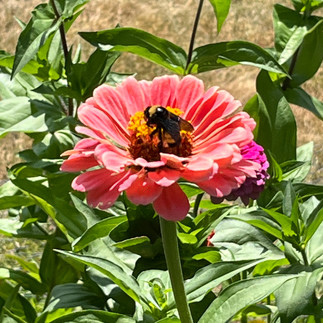Zinnias—The Joy of the Garden
- Amanda Rae
- Jun 3, 2024
- 3 min read
Updated: Jun 8, 2024
I've always wondered about the word "Zinnia." Apparently, it's named after the botanist Johann Gottfried Zinn, who discovered one of my favorite garden flowers. It's such a fun word to pronounce with that zippy "zz" sound and trust me, they're just as delightful to grow.

Zinnias are a powerhouse flower for any gardener who wants to do little but reap a large, bountiful harvest. And when I say bountiful, I mean it—zinnias produce an abundance of blooms over and over again.
But the bounty doesn’t stop at the blooms you’ll harvest. Zinnias are a haven for pollinators, attracting bees with their vibrant colors and providing a feast for butterflies. Imagine your garden buzzing with life all season long! Though zinnias are annuals, and you’ll need to replant them each year, they’re so easy to grow that they absolutely deserve a spot on your must-grow list.

Just so you know: Some of the links on my blog are affiliate links, and at no additional cost to you, I may earn a small commission if you make a purchase through these links. Your support helps me continue to share my love for gardening with you. Thank you, Amanda Rae!
Where to Plant Your Zinnias
Sunny Spots Zinnias thrive in sunny areas. Plant them where other flowers might struggle, as they can handle less-than-ideal soil conditions and prefer a drier environment.
Height and Growth Zinnias range in height from 12” to 48” depending on the variety. The more you cut them, the more they grow—marvelous, isn’t it? For a bushier plant, you can pinch them back when they're young. If you want longer stems for vases, let them grow naturally without pinching. Zinnias look best when they’re partially contained or with a backdrop to show off their beauty and keep them from sprawling in all directions.

Tough and Resilient Zinnias are incredibly tough, withstanding missed waterings with ease. Meaning they can do well in areas that are hard to reach with a hose. However, you still need to be on the lookout for powdery mildew, especially in late summer. When you spot that milky white tinge, cut out the affected parts of the plant immediately or pull out the plant entirely. This will help airflow between plants and prevent the mildew from spreading. This method is far more effective and environmentally friendlier than using chemicals. However, I understand the heartbreak of pulling diseased plants. If you decide to use a product against powdery mildew, I recommend this fungicide spray for organic gardening. Also, please spray your plants at dusk once all pollinators are soundly asleep in their beds.
Ideal Spots to Grow Zinnias in Your Garden
1. Along a Fence — Zinnias can create a colorful, living fence line.
2. Border Backdrop — Place them in the middle to back of a border for a stunning effect.
3. Fill Empty Spots — Perfect for corners, nooks, and crannies where they can provide camouflage. Just ensure they’re flanked by other plants or structures to provide support or else they can look leggy.
4. Among Sunflowers — Their height helps to cover the bare stems of sunflowers, creating a lush, full look.
5. Boulevard — Every year, I plant Zinnias in my boulevard, and they never fail to impress.
Where Not to Plant Zinnias
1. Border for Path — Zinnia can get a bit too unruly and bushy for a neat pathway border.
2. Alone — This might be a personal opinion; Zinnias look their best when planted en masse or with companion plants.
3. Containers — Again, the wild and free Zinnia spirit is not well-suited for container life (in my opinion).
The Best Zinnia for Your Garden
Now that you know where Zinnias will thrive and shine, it's time to choose from the zillions of beautiful varieties for your garden. Consider these key characteristics to guide your decision: single or double blooms, solid or multi-tone colors, and small or large centers. Each Zinnia offers its own unique charm, ready to bring vibrant life to your garden.
Go, Plant, Some Zinnias
You simply cannot go wrong with Zinnias. Their easy-going nature, vibrant display, and pollinator-friendly attributes, make them a top pick for both beginner and experienced gardeners. So, grab a packet of Zinnia seeds and find the perfect sunny spot in your garden.
Happy gardening!
Amanda Rae
_edited_edite.png)












Commenti